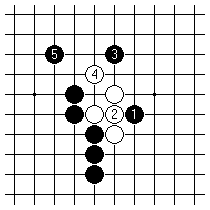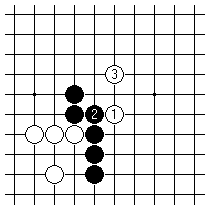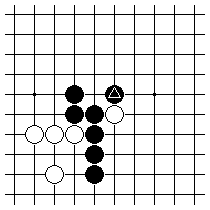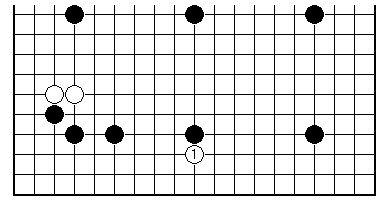

"Hopscotch". That was your initial reaction to the way the play in a game of Go jumps around from one area to another. Understanding the dynamics underlying the apparent agreement that one place is played out, and another requires attention, is a basic challenge for the beginner.
How does it seem now, from the height of your experience of around 50 games played?
"I'm still not sure about when you can safely ignore your opponent's last play. But I do see that there are usually plenty of other interesting moves, if you are able to take the initiative."
One way to use a computer to study Go, now that game files and programs to read them are easily obtained, is to observe how strong players allocate their plays to different parts of the board. Without trying to understand the fine detail of the sequences, it is possible to follow the play as a collection of "phrases" local to one fight. Forcing moves played and then left to fend for themselves are one of the more striking phenomena seen, when you look at games punctuated in this way.
So, let's consider the business of recognising threats. Any strategic game involves the threat/parry mechanism; and moves up to a higher level of play when both players are capable of seeing the ordinary types of threats, and responding in an apt way.
Go constantly throws up transparent threats to capture (atari plays). Threats to kill, by taking away the two eyes in a group, can be much more obscure. The correct way to treat them, from the point of view of long term improvement, is to rely on your own analysis - don't be bullied into answering them just because the opponent glares significantly at that part of the board while making the play.
Threats to break into territory must be treated with great respect. If you have more than one weakness in your territory - for example two cutting points in close proximity - or if there are some presumed dead stones of your opponent's stranded inside it, there is a fair chance that in combination with a move on the outside, some tactic for breaking in will succeed. Again you ought to trust your own careful analysis, rather than playing "just to be on the safe side".

Threats to cut, "peeps" in Go terminology, are an important factor in the cut-and-thrust of fighting. In this example Black 1 peeps, and White 2 connects. Then Black 3 is a good attacking play. The effect of Black 1 is to hamper White's development. Black needn't spend time defending this stone if White later turns to attack it.

This example of a peep is a little different. White 1 and 3 are a good attacking combination. But White shouldn't omit 3.

If Black had a chance to play the triangle stone, after the peep and connection, it would be a very handy improvement in the Black group's shape. White would regret having played the peep in the first place.

When it comes to playing handicap Go, it is most important for Black to recognise White's threats. Typical is this contact play White 1. You'd have thought that the threat was obvious. White has played once in contact with the Black stone on the side. A second such play and White will have a local advantage.

It is surprising how often Black jumps away from the crucial area of fighting, with a play like 2. Here perhaps Black's idea is to preserve territory in the left-hand corner. However this gives White a moment's respite, in which to build a viable group on the side. As shown, the sequence is a contrast between Black's ponderous play and White's agility, ending with the right-hand corner coming under a double-approach attack.

It is one of the more reliable rules for playing Go that contact plays should be treated as threats. Black should answer White at one of the points A, B, C or D. Which one matters less than the principle of keeping one step ahead in the contact fight. There are cases where contact plays are ignored, to do with ladder-breakers or ko threats; but local disadvantage can always be expected to follow.
First published 10 August 2000 as On Your Side on MindZine,
Go Learning
© Charles Matthews 2000.